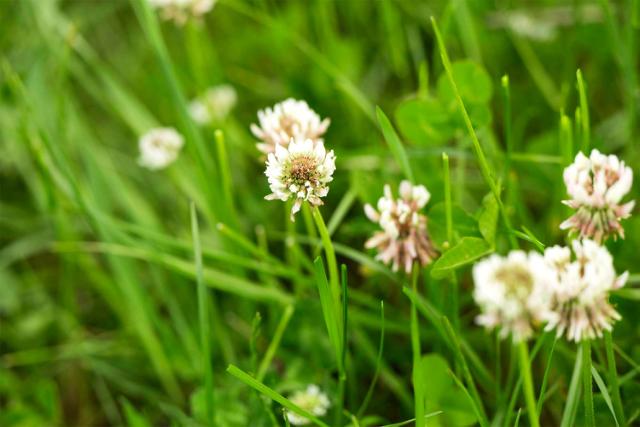DLF Alfalfa also performs at its best in combination with grass
Tall Fescue PLUS is an upgrade compared to ordinary tall fescues. Simply put, you mix the best from tall fescues with ryegrass genes, including higher digestibility and faster establishment.
A seed mixture containing DLF Alfalfa and grasses is a three in one solution:
- Improves the feed value through an optimal ratio of energy and protein
- Makes it easier to conserve as silage and exploit for grazing
- Offers more reliable feed production during dry periods
With alfalfa-grass mixtures you get
Increased protein content
The dry-matter protein content of DLF Alfalfa is up to 20%. In grasses it is up to 14%. By mixing the two, you can increase protein content in your forage by 1-5%.
Decreased sugar content
Grasses have high dry-matter sugar levels, sugar content in DLF Alfalfa is somewhat lower. When you mix the two, you achieve a sugar content that is roughly midway between the two.
Feed value of alfalfa-grass mixtures
The dry-matter feed value from DLF Alfalfa-and-grass forage is 165 g protein/kg, and its energy is 0,85 UFL/kg (UFL = unité fourragère lait = milk feeding units). Pure grasses have a slightly higher energy value of 0,88 UFL/kg, but are a much lower protein source at 113 g/kg.
Research carried out by DLF showed how various combinations of DLF Alfalfa and Festulolium (Festuca and Lolium types) altered the yield of dry matter, protein content, and digestibility:
More milk from forageSource: DLF R&D trial network |
|||||
|---|---|---|---|---|---|
| DLF Alfalfa Daisy |
Festulolium Perun |
50% Perun 50% Daisy |
Festulolium Hykor |
50% Hykor 50% Daisy |
|
| Yield, Ton DM/ha | 9,5 | 14,5 | 14,4 | 13,6 | 12,7 |
| % Protein in DM | 19,7 | 11,4 | 17,9 | 11,9 | 16,8 |
| % Digestible Organic Matter | 70,0 | 74,9 | 72,7 | 70,1 | 67,0 |
Silage characteristics of maize, grass, and DLF AlfalfaCharacteristics and how to improve the diet |
||
|---|---|---|
| Feeding source | Main characteristics | How to improve the diet |
| Maize | High energy concentration (carbohydrates - mainly starch) Low protein content and cell wall content (NDF) | Protein - soya concentrates, legumes. Fibre especially NDF- grass. DLF Alfalfa, straw |
| Perennial grass-legume mixtures | High content of fibre (NDF) and protein (legumes in particular) Medium energy concentration |
Energy-maize silage. grain concentrates Eventually more protein |
| DLF | Very high content of protein Low energy concentration, low silage coefficient |
Energy - Maize silage, grain concentrates Silage additives |
DLF Alfalfa is a more reliable feed source during dry periods
During spring and summer droughts, the dry-matter yield from grass-and-alfalfa seed mixtures can be up to four times higher than from grass-only mixtures.
A recent Belgian study (presented by Knoden, Hautot, Decamps at Journées AFPF – Paris 21–22 March 2016, showed how the addition of alfalfa to grass-seed mixtures altered the yield in three locations. They analysed the harvests from three years and found that fields with alfalfa produced significantly more feed in all but one location. The site that showed no advantage was the one that enjoyed sufficient rainfall throughout the growing period.
Grassland legumes boost milk productionComparison of digestibility, intake, and milk production |
||||
|---|---|---|---|---|
| Pure ryegrass | Red Clover/ Grass |
White Clover/ Grass |
Lucerne | |
| Digestibility DM | 72 | 69 | 72 | 64 |
| Silage intake kg DM/cow/day | 11.4 | 12.9 | 13,2 | 13.6 |
| Kg milk/cow/day | 26.5 | 31.0 | 30.7 | 29.3 |
Comparison of digestibility, intake, and milk production (kg Energy Corrected Milk) per cow per day for silage made from pure ryegrass, red and white clover-and-grass mixtures, and alfalfa. Dewhurst, 2003.
DLF Alfalfa improves farm self-sufficiency
The tables below show the effect on protein and energy production by introducing 10 hectares of DLF Alfalfa into the rotation.
Autonomy with and without alfalfafor Protein and Energy needs |
||
|---|---|---|
| % Autonomy | Protein | Energy |
| Without Alfalfa | 15 | 40 |
| With Alfalfa | 30 | 61 |
Hectares on the farm before and after introducing 10 ha alfalfaSource: A. Uijttewaal, Y. Carel, S. Battegay* |
||
|---|---|---|
| Hectares | Before | After |
| Alfalfa | 0 | 10 |
| Oilseed/cereals | 75 | 76 |
| Silage maize | 47 | 36 |
| Grassland | 53 | 53 |
| Total | 175 | 175 |
*ARVALIS-Institut du Végétal. Journées AFPF – March 2016
Research shows that alfalfa reduces feeding costs
Surveys undertaken in France show how the introduction of a small percentage of alfalfa cuts feeding costs. The average saving was 6€/1000L; survey results ranged from 0€ to 12€/1000 L milk.
Nine projects introducing alfalfa in the forage ration to reduce feeding costPublished by Institut de l’Elévage 2011 “Les réseaux d’élévage”
|
|||
|---|---|---|---|
| Region of France | System | Area (and % of total) containing alfalfa | Economic impact |
| Landes | Milk+ sales crops | 5 ha (8%) | + 4 € /1000L |
| Haute Marne | Milk+ sales crops | 8,8 ha (4%) | + 12€ /1000L |
| Cher | Milk+ sales crops | 8 ha (4%) | + 10€ /1000L |
| Loiret | Milk+ sales crops | 2 ha (1%) | + 5 € /1000L |
| Indre et Loire | Milk+ sales crops | 8 ha (4%) | + 11 € /1000L |
| Nord | Milk+ sales crops | 5 ha (5%) | + 3-5 € /1000L |
| Loire- Atlantique | Specialised milk | 4,5 ha (6%) | + 0 € /1000L |
| Marne | Milk+beef+ sales crops | 17,5 ha (5%) | + 9 € /1000L |
| Mayenne | Milk+beef+ sales crops | 3,5 ha (5%) | + 6 € /1000L |
